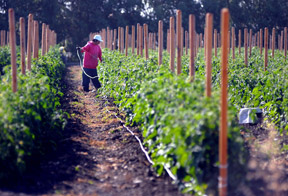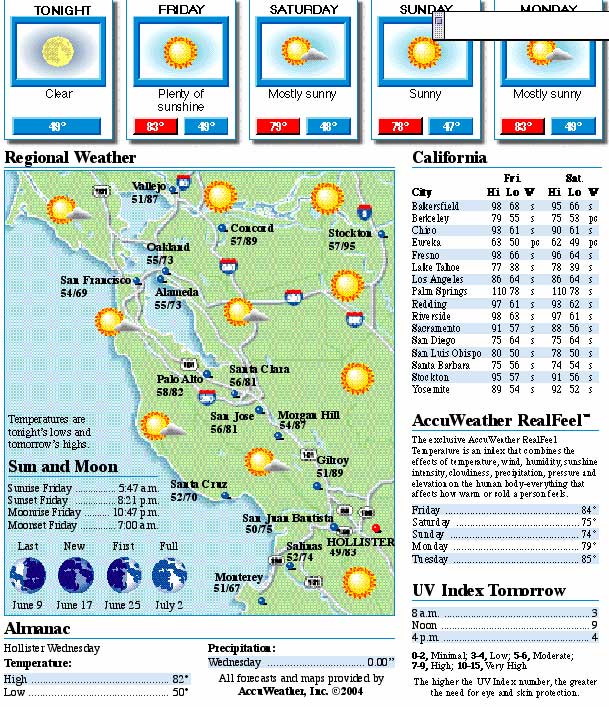Ag worth $293 million to SBC in 2007
Agriculture brought San Benito County more than $293 million in
2007.
That’s the figure reported in the annual San Benito County Crop
Report, released last week by county Agricultural Commissioner Paul
Matulich.
Ag worth $293 million to SBC in 2007
Agriculture brought San Benito County more than $293 million in 2007.
That’s the figure reported in the annual San Benito County Crop Report, released last week by county Agricultural Commissioner Paul Matulich.
The figure is the highest ever attained in the county, up almost 8 percent from the $270.9 million recorded in 2006.
Agriculture is easily the county’s leading industry, but Matulich cautioned that reports of gross income mask net profits that may be very modest. Some crops, he said, are produced at a loss.
“The prices have been stinking,” Matulich said. “Somebody’s making a lot of money between the grower and the supermarket.”
Matulich also said that he expects 2008 gross earnings to be lower, due in part to rising fuel prices and scarce water. Diesel hovers around $5 a gallon, up nearly $2 over this time last year.
A glance at the report reveals the volatile nature of farming. While nursery stock held its position as the county’s top valued crop at $34.4 million, three of the county’s top 10 crops dropped from the list, replaced by three others. For the first time ever, Matulich noted, fresh market tomatoes made the short list.
Fresh tomatoes were the ninth most valuable crop, at $14.2 million. Also new to the list were mixed leaf lettuce, $18.6 million, and other livestock and poultry products, No. 10 at $13.5 million.
Matulich said the appearance of other livestock and poultry is due to the arrival of a major poultry producer, Foster Farms, two years ago. Light rainfall brought declines in cattle and hay production.
Nursery stock is produced on a relative sliver of the county’s arable land, just 669 acres farmed by four producers. Under ideal conditions, nursery stock can bring in $100,000 an acre, Matulich said.
A 2006 E. coli contamination scare in spinach brought the region unwanted national attention. In 2007, growers devoted nearly 1,000 fewer acres to the crop, but higher per-acre yields brought production up by 1,000 tons, to 16,975 tons. That produced a higher gross earnings of $17 million for the leafy crop.
Vegetable and row crops continue to grow in importance while fruit and nut crops struggle to hold their own. In 2007, vegetables brought in $182.2 million, compared to $37.9 for fruit and nut crops.
Per-acre yields of most vegetable crops continue to grow, a phenomenon Matulich attributed to technology. “They’re getting better tonnage,” he said. “It’s smarter use of fertilizer, ideal conditions and drip irrigation.”
The county’s nascent olive oil industry appeared in the report for the first time, with 110 acres producing 138 tons of olives, valued at $113,000.
Wine grape acreage continues to grow, to 3,806 in 2007, with sales of $24.2 million.
Apricot and walnut acreage shrunk again. The county is now home to 1,796 acres of walnuts and 729 of apricots. Walnut growers got better prices in 2007, averaging $2,166 per ton over $1,507 a year earlier. Prices for other fruit and nut crops edged lower.
There are more people in San Benito County than cattle, a statistic that could not always be claimed. With about 55,000 residents of the human variety, San Benito County is home to 45,200 head of cattle.
A list of miscellaneous crops illustrates how varied San Benito County’s market basket is. Among the region’s more exotic crops are frisee, Oriental kale, rapini, arugula, kohlrabi, rutabagas, borage, parsnips, collards, fennel and okra.
Many of the more unusual crops are produced by organic growers who are at the vanguard of a growing trend toward organic production. Matulich said the county now has about 30 commercial organic growers, producing some 60 crops on more than 6,100 acres.
The annual Crop Report is available at the Agricultural Commissioner’s office at 3220 Southside Road.








